
NONPROFIT TECHNOLOGY
Turn technology into a strategic advantage — not a source of risk or overwhelm. This collection of expert-led videos helps nonprofit leaders use digital tools to strengthen operations, streamline communication, protect data, and guard against fraud.
Explore real-world guidance on choosing the right software, automating workflows, securing donor and client information, managing compliance, and building a more efficient tech stack. Our nonprofit technology experts break down what matters most: from CRM systems and AI tools to cybersecurity, backups, and fraud prevention.
Whether you’re selecting your first platform, improving internal processes, responding to a data breach, or preparing your team for digital transformation, these sessions make technology accessible, mission-driven, and safe — so your organization can operate with confidence and keep the focus on impact.
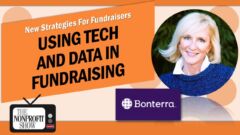
Tech, data, and generosity are not abstract buzzwords—they’re concrete levers that can stabilize funding, expand impact, and re-energize exhausted fundraisers. Chief Fundraising Officer Kimberly O’Donnell of Bonterra joins us to map out how recurring giving, trust-based philanthropy, and AI-powered tools can move the entire sector from scarcity thinking into a new “generosity generation.”
Kimberly starts by reframing recurring giving as non-negotiable infrastructure, not a nice-to-have tactic. As she puts it, “Recurring giving is essential for nonprofit sustainability. Just no, hard stop there.” Bonterra’s own research shows why: in its Meet the Moment report, 58% of federally funded nonprofits report financial instability this year. In that environment, a predictable base of sustainers—monthly and annual—can keep programs moving even as federal funds, disaster response dollars, and one-time grants fluctuate.
She shares a compelling case study: a Bonterra client that introduced three choices on its donation page—one-time, monthly, and annual. By normalizing both monthly and annual recurring options, that organization grew from zero sustainers to more than 65,000, proving that donors will enthusiastically choose ongoing support when invited clearly and confidently.
Kimberly also dismantles the common boardroom fear that sustainers will cannibalize major gifts. In her view, that’s simply a myth. Monthly donors should be seen as high-value relationship partners whose lifetime contributions, planned gifts, and sponsorship potential can grow over time. The real problem isn’t “small monthly donors”; it’s organizations deciding on behalf of donors when and how they will give.
From there, the conversation widens. Kimberly explains how Bonterra’s vantage point—serving nonprofits, community foundations, CSR programs, and public agencies across the social good ecosystem—reveals sector-wide patterns in real time. Trust-based philanthropy, she notes, hasn’t disappeared; it’s evolving. Funders are becoming more intentional, concentrating resources on core pillars while streamlining reporting and using their networks to introduce nonprofits to new corporate and philanthropic partners.
Then comes the big vision: Bonterra’s “30 by 33” initiative to move charitable giving in the U.S. from a stagnant 2.5% of GDP to 3% by 2033. Achieving that shift, Kimberly argues, will require data, AI, and human connection working together—what Bonterra calls the generosity generation.
AI, in particular, is already reshaping daily fundraising practice. Bonterra has been using agentic AI since 2016–2017, and its new tools are built with a “human in the loop” philosophy so fundraisers can test, refine, and own their messages.
Kimberly’s closing message is both empathetic and urgent: acknowledging nonprofit exhaustion yet pushing leaders to resist retreat: this is not a moment to slow down—it’s a moment to experiment, ask bolder questions, and lean on tools that make the work more sustainable.
#TheNonprofitShow #NonprofitFundraising #BonterraTech
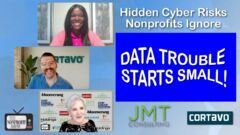
Who actually owns data protection in a nonprofit? In this fast-paced conversation, host Julia C. Patrick sits down with Taysha Adams, Manager Technology Support at JMT Consulting, and Josh Fricovsky, Engineering Director at Cortavo, to tackle the uncomfortable truth: cybersecurity is no longer “someone else’s job.”
Taysha starts with a reality check: most vulnerabilities don’t begin in a server room. They start with everyday behavior. From checking work email on public Wi-Fi to logging in on a friend’s device, casual habits open doors to attackers. As she explains, “Everybody’s responsible for data security and protection… most vulnerabilities do come in from the end users.” JMT has spent more than a year realigning internal processes, tightening device controls, and partnering with Cortavo so their own team—and their clients—are better shielded.
Josh builds on that by showing how fast the threat landscape is evolving. Cortavo’s job as a managed service provider is to sit on the “bleeding edge”: endpoint protection, email security, MFA, VPNs, and now mobile device management for a workforce that increasingly works on the move. He notes that “the cost of inaction is going to be 10 to 100 times more than” the investment in proactive security. It’s not just about tools; it’s about culture, education, and leadership setting the tone.
The conversation then moves to the devices we use every day. Laptops, tablets, and phones are cheaper and more plentiful than ever, but every extra device is another front door. The guests stress that nonprofits need clear policies for using personal phones for work, along with mobile device management to protect company data without “controlling” the phone itself.
AI takes the discussion to another level. Both guests are enthusiastic users, but they warn that unregulated use is dangerous. Taysha urges organizations to set guardrails and favor licensed or enterprise tools so prompts, donor details, and templates aren’t quietly training public models. Josh goes further, recommending offline or private LLMs for sensitive data and pointing out that attackers are already using AI for sophisticated social engineering, including voice cloning and real-time credential theft.
Finally, the trio frames cybersecurity as a governance and financial issue, not just an IT problem. Data loss can mean lost clients, destroyed reputation, and even the end of an organization. Partnering with firms like JMT and Cortavo, building internal awareness, and treating security like an essential protection policy—not a luxury—are presented as non-negotiable steps for modern nonprofits.
This episode is a must-watch for executives, boards, and staff who touch data in any way—which is everyone.
#TheNonprofitShow #NonprofitCybersecurity #DataProtection

When nonprofits tackle a major platform shift, the tech is only half the story. JMT Consulting pros Brady Haslebacher (Director of Program Management) and Dagmar “Dagi” Stanton (Manager of Education Services) map out the human and operational moves that make change stick.
This informative episode breaks down why big projects stall—no top-down buy-in, poor internal communication, and late user inclusion—and then shows how to reverse it with a clear cadence, a requirements doc everyone can point to, and training that respects different learning styles. You’ll also hear how to build champions: start with pain points, practice real workflows, revisit what was decided four weeks ago, and connect dashboards to daily tasks so executives and staff share one view of success.
Brady puts it plainly: “Without communication, missions fail.” From day one, he presses leaders to create a real pre-decision phase—document requirements, prioritize reporting needs, and establish ownership from the C-suite through front-line users. His data points are clear: a typical engagement runs ~90 days to go-live, ~60 days of hypercare, and one to two working sessions per week—about six months end-to-end.
Dagi brings the trainer’s lens, focusing on behavior and confidence. She works with teams who didn’t even choose the new system, flipping reluctance into momentum by making sessions unexpectedly fun and practical. Her mantra cuts through inertia: “The right answer isn’t ‘because we’ve always done it that way.’” She intentionally sets up safe mistakes so users learn how fast they can correct entries—lowering stress and building mastery. The result is less dread and more people who actually enjoy using the tools.
In closing, you’ll get details on JMT’s Innovate 2026 (Washington, D.C., May 4–6): a pre-conference day for deep skill building, followed by multi-track sessions that span software, finance, management, and sector trends—plus the chance to meet your people in person.
If you’re planning a system change—or sitting in one right now—this conversation gives you timelines, team roles, and a playbook to move from anxiety to adoption without the hair-on-fire moments.
#ChangeManagement #NonprofitTech

Fundraising folklore says the “one big donor” will save the day! Katie Gaston, Director of Product Marketing at Bloomerang, dismantles that ‘chase’ and replaces it with steady, systems-based fundraising. Katie frames her role in product marketing as disciplined storytelling: know your audience, understand what they care about, and read the landscape by listening, surveying, and researching. That same mindset applies to development. Start by cleaning and maintaining data in your CRM so you can actually see who is volunteering, giving monthly, and staying loyal over time. Automation can help—address updates, enrichment, and built-in features you may not have enabled.
Katie moves the conversation from wishful thinking to practical math: “Research shows you will actually raise quite a bit more if you just focus on the donors already in your database.” Loyal monthly givers, long-tenured annual donors, and volunteers represent reliable lift and lower risk than a single major-gift “unicorn.” She urges teams to use AI thoughtfully. Whether through platform-native tools or carefully configured external assistants, AI can scan patterns, surface bequest prospects, identify mid-level donors to upgrade, and recommend next actions.
This timely episode then maps a clear donor journey. Thank first-time donors within 48 hours, then vary contact across channels—email, short mobile video, text, and a newsletter update—to nurture toward recurring and mid-level giving. Build an automated sequence now so December’s influx becomes January’s momentum, not a one-month spike. Even modest, realistic steps matter: one sequence, one board call plan, one January volunteer invitation for first-time donors.
Boards and leadership often share the myth. Bring them along with evidence. Use AI or CRM reports to present streak length, recency, and consistency. Real stories persuade too: a decades-long modest donor who later made a significant bequest once the relationship was cultivated. Katie offers a simple activation: “A board thank you call will actually increase the next gift size by up to 40%.” Pair that with the “48 hour” rule and you have a repeatable, high-leverage play.
Finally, Katie’s suggests we reframe year-end. December isn’t a finish line; it’s the on-ramp for the new year. Lean into the cultural reset of January—invite, ask why they gave, listen, and keep the story going. The takeaway: stop chasing the mythical donor and build a system that compounds loyalty you already have.
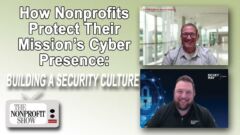
Cybersecurity isn’t just firewalls and tech jargon—it’s people, habits, and everyday choices. Kicking off National Cybersecurity Awareness Month, we bring together two voices who live this every day: Michael Nouguier, Partner, Cybersecurity Services at Richey May, and Tony Rehmer, Senior VP of IT at Children’s Miracle Network Hospitals (CMN Hospitals). Their message is clear: strong security starts with culture.
Tony sets the tone early: “We take a major part, but it is everyone.” In other words, security isn’t a back-office task—it’s a shared responsibility. With hospitals, HIPAA, and multi-state operations in the mix, CMN Hospitals treats staff as the front line. That means training that actually sticks: shorter, “microlearning” nudges delivered through internal channels, real examples, and peer-to-peer conversations. As Tony puts it, “We never, ever shame a person.” Instead, they use supportive coaching after incidents to encourage fast reporting and continuous learning.
Michael maps the big picture. Attacks have matured, and wishful thinking won’t cut it. “Hope has then become a liability when it’s your only defense.” The antidote? Make security part of the mission—top-down and day-to-day. That looks like updating mission statements (“do the work securely”), enabling multifactor for everyone (leaders included), and building a culture where staff quickly raise their hand when something feels off. He provides memorable visual: “Everybody needs a pitchfork… so they can do what they need to do to protect your organization.”
The conversation gets real with a story from CMN Hospitals at the start of COVID-19. Threat actors bought credentials on the dark web, slipped into a mailbox, swapped a message body for malware, and re-sent it. Because staff had been invited into the security effort, the team was alerted within five minutes. That fast reporting changed the outcome. Culture wasn’t a slogan; it was the safety net.
Both guests agree: this is ongoing work. Threats keep shifting—from credit cards to ransomware and data theft—so messaging, training, and audience targeting must evolve too. Practically, that means appointing security champions, aligning IT with communications pros who can translate across departments, and weaving security into leadership conversations and board funding decisions.
Takeaways you can use: treat people as partners, keep learning in snackable moments, celebrate fast reporting, and put “securely” in your strategy—not just in your tech stack.

In this Nonprofit Power Week conversation, we sit down with Jen Blasy, Manager at Your Part-Time Controller, to confront a topic many organizations would rather avoid: fraud in the nonprofit sector. Jen is unequivocal about the stakes: “Fraud has been a constant. It may look different, but it’s still happening.” She explains why the sector’s empathy, trust, and lean staffing models can unintentionally create exposure—especially in a remote and hybrid world where e-mail, text, and chat now mediate so many approvals and financial transactions.
Jen moves past labels to show how fraud actually occurs. She refreshes the classic “triangle” of pressure, rationalization, and opportunity by adding capability and personal ethics, then wraps it all in culture. Tone at the top matters, she notes, because expectations, zero tolerance, and open conversation are often the only real deterrents. “We need to normalize the discussion of it so that it becomes more normal to talk about,” Jen adds, urging leaders to speak plainly with staff, boards, auditors, and yes—donors—about risks and responsibilities.
Concrete scenarios make the message land. From stolen cards being “tested” on donation pages to refund requests designed to route money out through alternate channels, Jen shows how seemingly donor-friendly instincts can be weaponized. She pushes organizations to map their most common money-in and money-out pathways, document updated controls that fit remote workflows, and rehearse a response plan before a crisis. Who do you call first? Legal counsel, your insurer, your auditor, a board champion? Decide now, not mid-incident.
The throughline is sector solidarity. Because incidents are underreported and under-prosecuted, offenders can quietly move from one organization to another. Jen challenges leaders to think beyond their own walls and treat transparency as community protection. Make fraud risk a standing board agenda item, ensure auditors’ annual fraud conversations are substantive, and appoint an internal champion to coordinate policies, training, and continuous improvement.
Fraud will not be eliminated, but its impact can be contained by stronger culture, modernized controls, and candid conversation. This episode equips executives, finance teams, and fundraisers alike to recognize where they’re vulnerable and to act. As Jen frames it, progress starts when we stop whispering about fraud and start planning together.
#TheNonprofitShow #NonprofitFinance #FraudPrevention

Nonprofits want the speed of automation and the promise of AI—but Alicia Eastvold, Department Leader for Client Technology Solutions at Your Part-Time Controller (YPTC), explains why many orgs stall at the starting line: messy, bloated, and fragmented data. Her central thesis is simple and powerful: “We can’t speed things up if it’s not organized, and we can’t write simple rules around it for where it belongs.” From the first minute, Alicia reframes “data hygiene” away from fear and toward usefulness—think Marie Kondo for systems: keep what serves the mission, archive the rest, and label everything so your “smart assistant” can actually find the hammer.
Alicia maps two common failure modes: too much information (endless, unreadable reports) and poor structure (the same concept scattered across donor CRM, accounting, and spreadsheets). Both grind automation to a halt and produce costly mistakes in grant allocations, budgets, and forecasts. Her practical fix: decide what you need going forward, set a cutoff, inactivate legacy categories, and build simple, durable rules that can run 1,000 times. As she puts it, “Think big about what would happen if I had to do this thing a thousand times and plan your process that way.”
A standout story: a client wanted a complex custom payroll allocation tool. After examining their cluttered chart and inconsistent rules, the team cleaned the system, documented clear rules, and discovered an off-the-shelf cost allocation tool that did the job at a fraction of the price. Takeaway: better structure often beats bespoke code.
The stakes are real. Misallocations can snowball into seven-figure problems, finger-pointing between development and finance, and restricted funds that can’t be used where they’re most needed. Clean, rule-based data unlocks credible budgeting, forecasting, and the ability to ask funders for the right dollars—including flexible, unrestricted support. It also fuels data storytelling that boosts trust and investment: when leaders visualize program costs, funding gaps, and outcomes with clarity, credibility skyrockets.
Bottom line: start today. Choose what matters for the next 12–24 months, archive the past, enforce naming and categorization rules, and think like an enterprise—no matter your size. Clean data returns time to your people, turns AI from buzz to utility, and powers decisions that move the mission!

AI isn’t a magic wand—but it can absolutely help nonprofits do more with less when you understand what it is, where it fits, and how to use it wisely. In this energizing conversation, technology associate and CPA Christine Chacko from Your Part-Time Controller (YPTC) explains the practical difference between automation and AI, when to use each, and how to keep data safe while you experiment and learn. As Christine puts it, “AI is actually a form of automation,” but it handles open-ended, judgment-heavy tasks while traditional automation follows clear, narrow rules. Think rules for categorizing expenses (automation) versus analyzing trends, benchmarking, and surfacing insights across donor segments (AI).
Christine offers real nonprofit examples: blend automation to roll up donor data by type, then ask AI to interpret changes year over year, spot seasonality, or flag post-pandemic shifts. She shows how AI shines as a writing helper—drafting grant narratives tailored to funders’ preferences or condensing verbose copy into crisp executive summaries—while reminding us to review outputs for voice, accuracy, and appropriateness. “We really like to think of it as a thought partner,” she says, perfect for bouncing ideas, testing messages, and clarifying complex financial stories for boards.
Security matters, too. Christine’s guidance is simple and strong: read the fine print, know what you opt into, and understand the difference between models embedded in trusted systems and those that reach out to other tools. She introduces agentic AI—systems that can act on your behalf (e.g., access Outlook, browse the web, schedule emails)—and explains why permissions, policies, and internal controls must come first. Hallucinations are less frequent in newer reasoning models, but review remains essential—especially for grants and external communications where stakes are high.
Finally, Christine maps the near-term horizon: expect broader, more accessible agentic AI inside finance, IT, customer support, and daily workflows. Success won’t come from tools alone; it comes from culture—clear use cases, communication, training, and solid processes. Used well, AI reduces drudgery (transcripts, notes, routine emails) so nonprofit teams can focus on judgment, relationships, and mission results.

Nonprofits lean on outside platforms to save time and stretch budgets—but those relationships can quietly expose sensitive donor, client, and payment data. In this episode, Senior Cybersecurity Advisor Parker Brissette of Richey May explains how to recognize and manage third-party software risk before it becomes tomorrow’s headline. He starts with a simple lens: follow the data. Where is it stored? Who can touch it—directly or indirectly? Many teams only think about contracted vendors, but Parker widens the aperture to “shadow IT” and consumer tools staff use without formal approval. As he puts it, “Third parties is really anybody that can touch the data at any point in your business, whether you have an agreement with them or maybe not.”
From privacy regulations (GDPR, CCPA) to sector-specific rules (HIPAA, PCI), nonprofits carry legal and reputational exposure the moment personal information enters their systems. Parker offers practical steps: inventory paid tools via your accounting system; ask, “If this vendor vanished tomorrow, what would break?”; and press vendors for proof—SOC 2 reports, ISO 27001, or completed security questionnaires. For organizations without a CIO, he recommends clear contracts and one non-negotiable safeguard: “The biggest thing that I recommend in any third-party engagement is setting an expectation of having cyber insurance, because that’s a big protection for you financially.”
AI enters the picture with both promise and peril. Consumer AI tools can learn from and retain your uploads, potentially exposing proprietary or personal information. Enterprise agreements (e.g., Microsoft Copilot) can offer stronger data protections, but only if configured and used correctly. Parker’s guidance is pragmatic: don’t ban AI; set guardrails, choose vetted tools, and train teams.
Finally, he urges preparation and transparency. Incidents can happen—even with good controls. Donors and corporate funders expect frank communication about what protections exist and what happens if data is exposed. Build trust now by documenting safeguards, validating vendors, and rehearsing your response.
You don’t have to be a security expert to make smart choices—but you do need a map: know your systems, test your assumptions, ask vendors for evidence, and write risk into your contracts and budgets. That approach turns anxiety into action—and preserves the trust your mission depends on.

Has your nonprofit ever had a simulated break-in to test your digital defenses? If not, you may already have an intruder inside!
Cyberattacks aren’t just happening to big corporations—they’re happening to nonprofits every day. And far too many organizations have no idea they’ve been breached until months later. Cybersecurity expert Michael Nouguier, Partner of Cybersecurity Services at Richey May, pulls back the curtain on the urgent, often-overlooked practice of penetration testing—known as “pen testing.” His message is blunt: if your nonprofit hasn’t done one, you may already be compromised.
Michael explains that a pen test is essentially a real-world simulation of a cyberattack, conducted by ethical hackers to expose weaknesses before malicious actors exploit them. “It’s like hiring a home inspector before you buy a house,” he says, “but instead of finding leaky pipes, we’re finding the digital doors and windows you’ve accidentally left wide open.” These gaps can exist in email, donor databases, websites, payment systems—anywhere sensitive information lives.
The process starts with scoping—identifying your organization’s tech environment, third-party tools, and data flows. From there, ethical hackers gather open-source intelligence (OSINT) to see what information about your nonprofit is publicly available, then attempt to exploit any vulnerabilities found. This may involve phishing attempts, network access attempts, or probing for weaknesses in online applications. Post-exploitation, the team determines how far they can move within your systems—accessing donor records, financial data, or confidential client files.
The findings are compiled into a detailed report, along with a letter of assessment that can be shared with insurers or contractual partners. In many industries, including healthcare, justice, and education, annual pen testing isn’t optional—it’s required by regulation or by contract. Yet, as Michael warns in this episode, many nonprofits sign agreements without realizing they’re agreeing to perform such tests.
Waiting too long is costly. IBM research shows that proactive security measures can save organizations over $200,000 per breach. On the flip side, skipping pen testing can raise your cyber insurance premiums—or get your coverage denied entirely. And because updates, new software, and staffing changes continually introduce new risks, pen testing isn’t a one-and-done task—it’s an annual checkup for your organization’s digital health.
Michael also touches on the human factor. When testing social engineering risks, you often don’t alert staff in advance—because real attackers certainly won’t. The goal is to create realistic conditions, not staged ones.
This conversation should serve as a wake-up call: penetration testing is not an optional luxury—it’s a frontline defense. Whether you hold donor payment information, confidential case files, or sensitive program data, you can’t afford to leave your cybersecurity to chance.

If you've ever worked in a nonprofit and found yourself fronting expenses on your personal credit card, you're not alone—and you're definitely not doing it wrong. But there's a better way. Our host sat down with GiveFront.com , to unpack how nonprofits can modernize the way they manage spending, reimbursements, and financial oversight.
Founder of GiveFront, Matt Tengtrakool, brings a unique dual lens to the discussion: one from years of hands-on experience running and managing nonprofit finances, and another from building financial technology designed specifically for the sector. His message is clear—nonprofits deserve modern tools to track spending, reduce fraud risk, streamline compliance, and eliminate burdensome reimbursement systems.
He explains that many organizations still operate with a single credit card passed around among staff—a system ripe for errors, delays, and a lack of accountability. GiveFront provides an alternative: customizable, trackable virtual cards that make it easy for even volunteers to make approved purchases. “You want to allow people to spend for your organization, but you also want control,” Matt explains. “And having the systems set up from the start is extremely important.”
The conversation covers common friction points between program teams and finance departments, shedding light on how better spend management can actually strengthen relationships across departments. Host Julia Patrick and Matt explore the psychological side of transparency, the real costs of missing receipts, and the ripple effects of poor policy enforcement.
Matt also shares how sales tax refunds—often ignored due to their complexity—can recapture up to 10% of an organization’s spending. With GiveFront’s built-in tools, nonprofits in states like North Carolina and Utah can automatically generate sales tax refund documentation without drowning in paperwork.
The episode wraps with practical advice: adopt a spend management platform, train your team on internal financial policies, and revisit those policies regularly. Because managing money well isn’t just about spreadsheets—it’s about trust, clarity, and making sure every dollar does the most good.

This fast episode plants more than a few seeds—it digs deep into the fertile soil of fundraising tech and AI, showing nonprofit leaders how to embrace new tools without fear or being overwhelmed.
Co-host Julia Patrick opens with her signature energy: “It’s always a good day when I get to work with my cohost Tony Beall,” . . .and what follows is an energizing discussion around modernizing fundraising practices. The duo tackles AI not as a villain, but as a brilliant assistant. As Tony puts it: “AI is a tool, not a takeover.”
From predictive analytics to donor segmentation, Tony outlines how AI empowers fundraisers to work smarter—not harder. He reminds us that AI “creates a tremendous opportunity for prospecting,” especially now that tools like ChatGPT are as common as Google searches.
Julia reflects on how her organization embraced AI early on. “It has revolutionized the way we do business,” she says, underscoring (not literally!) how prompts, personas, and platform features help tailor messaging to diverse donor groups.
Tony speaks to how “ChatGPT can help you refine messaging for different donor sets… it’s still your words, but it’s helping you shape the message.” He urges fundraisers to treat the tech as an editor—not a ghostwriter.
They also dig into CRM evolution, with Julia commenting, “What we get today is not what we’ll have tomorrow.” Tony shares how CRM vendors are racing to integrate AI and support their users.
The conversation rounds out with a focus on multi-generational training, acknowledging that not every team member shares the same comfort with digital tools. Tony adds that leaders must explain “why we’re doing this” so that staff can buy in, even if it feels uncomfortable at first.
This episode isn’t just about tech—it’s about change, mindset, and purpose.
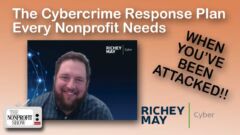
When a cyberattack hits your nonprofit, do you know what to do? Cybersecurity expert Michael Nouguier, Partner at Cybersecurity Services at Richey May, walks us through the essential steps every nonprofit must take—before, during, and after a cyber event. As host Julia Patrick notes, it's not a matter of if, but when, and being unprepared is no longer an option.
From clarifying what cyber insurance actually covers to practicing realistic incident response exercises, Michael offers a pragmatic and step-by-step guide tailored for nonprofit leaders. He points out, “Failure to plan is planning to fail,” and urges organizations to move beyond hope and into action.
The conversation dissects misconceptions, such as thinking IT alone can handle a breach or believing cyber insurance is a comprehensive solution. Instead, Michael recommends building internal resilience with tabletop exercises that include the board, C-suite, legal, and communications staff. These scenario-based run-throughs help teams build muscle memory and prevent panic when disaster strikes.
Third-party vendors—often a hidden weak spot—are addressed in detail. Michael reminds us, “You are the trusted data collector,” meaning nonprofits must ensure their vendors share the same security culture, including notification clauses and accountability.
What if the worst happens? Michael stresses calm, communication, and preservation of evidence. “Don’t delete anything,” he cautions, as doing so can sabotage forensic investigations and potential fund recovery. He also reminds leaders to report incidents to local authorities and the FBI’s IC3.gov, reinforcing the legal and ethical responsibility to act swiftly and transparently.
Perhaps one of the most human insights is around fostering a blame-free culture. Employees fearing punishment won’t report mistakes, making things worse. “Everyone—even me—has clicked a phishing link,” Michael admits, highlighting the importance of openness and psychological safety within teams.
Ultimately, this is a call to action for nonprofit leaders to shift from avoidance to preparedness. Cyberattacks are not just technical disruptions—they can financially and operationally dismantle an organization. With the right mindset, strategy, and communication plan, your nonprofit can weather the storm and keep its mission alive!
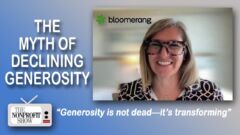
A clear message: “Generosity is not dead—it’s transforming”, says Ann Fellman, Chief Marketing Officer at Bloomerang. As headlines churn out fatigue-inducing stories of donor decline and uncertainty, Ann injects much-needed optimism rooted in data and strategy.
“We are in it now,” Ann declares about the $70 trillion wealth transfer, urging nonprofits to act instead of waiting for the perfect moment. Drawing from the latest Giving USA 2024 findings, she reminds us that individual giving reached a staggering $592.5 billion, with 66% of that coming directly from individuals. “Individual Americans are ready and willing to support,” she tells us.
This recent conversation navigates beyond donor behavior into practical strategy. Ann challenges fundraisers to rethink short-term vs. long-term planning and ‘get real about programming priorities: What must be done, what should be done, and what would be nice to do?’ She lays out a compelling scenario-based approach to planning for revenue shifts, especially in a landscape threatened by grant losses and funding uncertainty.
She also makes a strong case for recurring giving. “Would you rather have a one-time $100 gift or $10 a month for years?” she asks. Despite the low adoption rate, recurring programs offer sustainable, predictable revenue and are easy to implement with today’s tech. She even floats the bold concept of creating a “monthly giving officer”—a role few, if any, nonprofits have embraced but one that could radically improve outcomes.
Transparency, too, is no longer optional. Citing data from Bloomerang’s Mission: Retainable report, Ann points out that while 65% of donors crave regular impact updates, only 36% of nonprofits actually deliver them. In an era when trust is easily eroded, communicating funding gaps and showing how you're responding builds confidence and inspires donors to act.
As Ann beautifully puts it: “There is generosity. It’s alive and well.”
00:00:00 Welcome & Introduction to Ann Fellman
00:02:30 What Bloomerang Actually Does for Nonprofits
00:04:15 How Tech + People = Better Fundraising
00:06:15 The Truth About American Generosity
00:08:30 Giving USA 2024 Highlights: $592B Raised!
00:10:00 Generational Wealth Transfer: $70 Trillion Opportunity
00:13:00 Donor Communication Gaps and Impact Reports
00:15:00 Monthly Giving—The Most Underrated Strategy
00:20:00 Scenario Planning: Must Do, Should Do, Nice to Do
00:24:00 How Transparency Builds Donor Trust
00:27:00 Highlighting Funding Gaps Without Fear
00:30:00 Final Thoughts: Don’t Be Discouraged, Generosity Is Alive
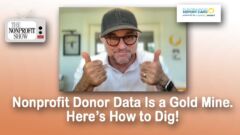
If you've ever wondered whether your nonprofit fundraising data is a treasure chest or a digital junk drawer, Greg Warner is here with a flashlight, a map, and a pickaxe. In this entertaining conversation, Greg—CEO of MarketSmart and creator of the Fundraising Report Card—joins host Julia Patrick to dissect the murky waters of metrics and help nonprofits move from guesswork to grounded strategy.
Greg kicks off with the backstory: MarketSmart’s 17-year evolution into a marketing automation firm helping nonprofits identify, qualify, and steward major and legacy donors. ‘The Fundraising Report Card’, born from this journey, now offers nonprofits a simplified yet powerful lens into donor behavior—showing not just what happened, but what it means.
Here’s the twist: until now, this tool has been free. But with over 27,000 users and a mountain of benchmark data, Greg’s team is rolling out a more robust version—with peer comparisons so relevant, they make national averages look like vague horoscopes.
And it’s about time. “Relevance creates resonance,” Greg shares, “But irrelevant data creates dissonance.” Nonprofits have long been running on emotional narratives and gut instincts. Greg invites you to reframe the conversation using donor lifetime value, retention data, and institutional memory—all quantified, all visual.
Julia comments how too many development pros spend two days prepping board reports for seven minutes of attention. Greg’s fix? Collaborative tools baked into the new version of the app, enabling real-time, cross-functional dialogue. Because why silo data when you can democratize it?
Want to stop flying blind and start mining gold? This episode is your blueprint.
#FundraisingData #DonorAnalytics #TheNonprofitShow
